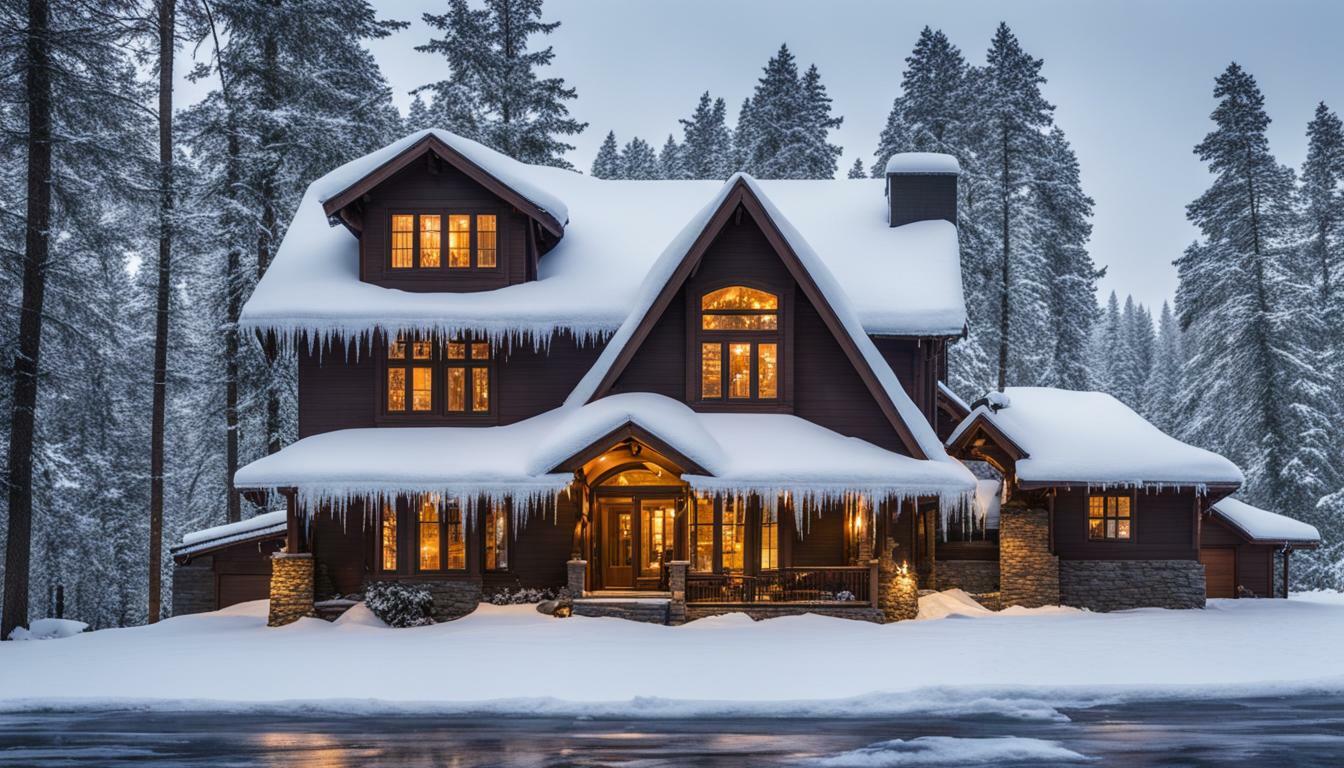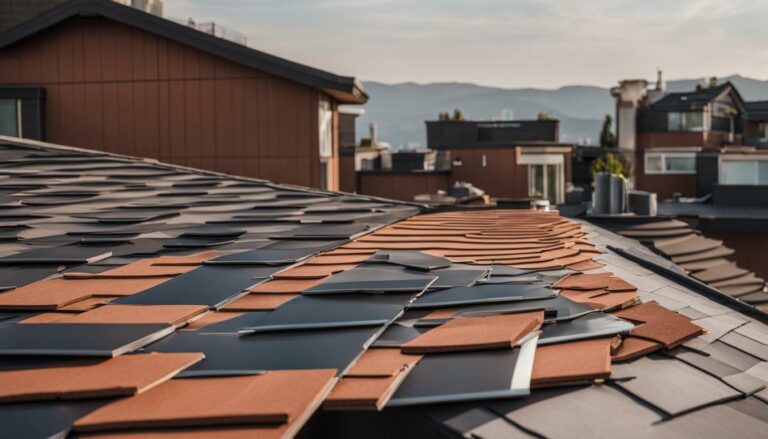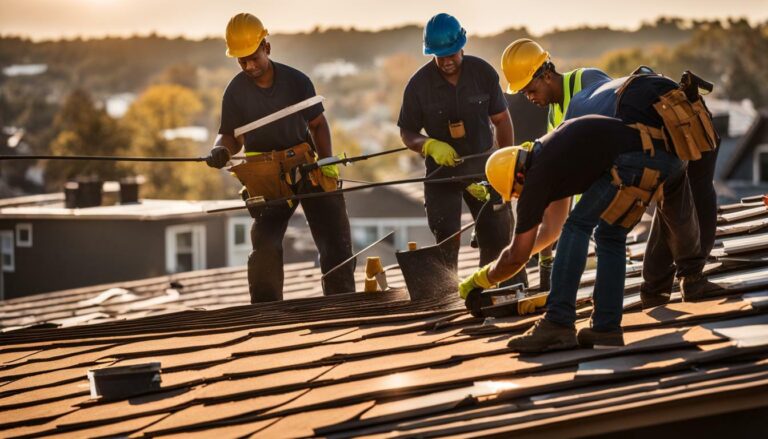Roofing Solutions for Heavy Snowfall Areas: Protect Your Home
Living in an area with heavy snowfall requires proper roofing solutions to protect your home from potential damage. Snow buildup can cause structural stress, damage to shingles, and even roof collapse. To ensure your home is well-prepared for the winter season, consider implementing the following roofing solutions:
- Prevent ice dams with heating cables: Install weather-resistant and insulated electric cables along your roof and gutters to keep ice out of the eaves.
- Calculate snow load: Determine the pounds per square foot your roof is supporting by assuming that every inch of snow depth equals 1.25 pounds per square foot.
- Remove snow with a roof rake: Use a long-handled roof rake to remove excess snow from your pitched roof, starting at the edge and working your way in.
- Call professionals for snow removal: If using a rake is not enough, hire a professional snow removal service for safe snow removal, especially for flat roofs or heavy snowfall areas.
- Choose suitable roof designs: Consider roof designs like gambrel, shed, hip, or gable roofs that can withstand heavy snow loads.
- Proper roofing solutions are essential to protect your home from heavy snowfall.
- Preventing ice dams with heating cables can help keep your roof and gutters free from ice buildup.
- Calculating snow load can help determine the weight your roof can handle.
- Removing excess snow with a roof rake can reduce the weight load on your roof and prevent damage to shingles.
- Hiring professional snow removal services is recommended for flat roofs or heavy snowfall areas.
By implementing these roofing solutions, you can safeguard your home against heavy snowfall and minimize the risk of roof damage. Remember, it’s important to regularly inspect and maintain your roof to identify and address any issues that may arise during the winter season.
Importance of Snow-Proof Roofs
Snow-proof roofs are crucial in heavy snowfall areas to ensure the longevity and durability of your home’s roof. The weight of accumulated snow can put immense stress on your roof, leading to potential damage, leaks, or even collapse. By investing in snow-proof roofs, you can protect your home and loved ones from the hazards posed by heavy snowfall.
Snow-resistant roofing materials are designed to withstand the weight and pressure of snow, ensuring your roof remains intact even in harsh winter conditions. These roofs are constructed with reinforced structures and materials that can bear the additional load, providing peace of mind during the snowy season.
When selecting snow-resistant roofing, it’s important to consider factors such as the pitch of your roof, the design, and the materials used. Steeper pitches, such as those found in gambrel, shed, hip, or gable roofs, are generally better equipped to handle heavy snow loads, as they allow snow to slide off more easily. Additionally, materials like metal, tile, or asphalt shingles are known for their durability and ability to withstand severe weather conditions, including heavy snowfall.
To ensure the effectiveness of your snow-proof roof, it is essential to have it installed by professional roofing contractors who specialize in snow-resistant roofing solutions. These experts can guide you through the selection process, ensuring your roof is properly designed and installed to withstand heavy snow loads and protect your home for years to come.

Preventing Ice Dams with Heating Cables
Installing weather-resistant and insulated electric cables along your roof and gutters can effectively prevent ice dams and safeguard your snow-proof roof. Ice dams occur when heat from your home escapes through the roof, causing snow to melt and refreeze at the eaves. This ice buildup can lead to water seepage, structural damage, and even roof leaks. By using heating cables, you can maintain a consistent temperature along your roof and gutters, preventing ice from forming.
Heating cables are specifically designed to withstand harsh weather conditions and are easy to install. They can be attached to the roof, gutters, or downspouts, providing a reliable source of heat that keeps the snow and ice from accumulating. These cables are energy-efficient and can be controlled with a thermostat, ensuring that they operate only when needed.
Proper installation is crucial for the effective use of heating cables. It’s essential to consult with a professional to determine the best placement and ensure that the cables are installed correctly. Additionally, regular maintenance is necessary to check for any damage or malfunction that may affect their performance. By investing in heating cables and taking the necessary precautions, you can protect your home from the damaging effects of ice dams and maintain a snow-proof roof.
Benefits of Installing Heating Cables:
- Prevents ice dams and water seepage
- Safeguards your snow-proof roof
- Reduces the risk of structural damage and roof leaks
- Energy-efficient and cost-effective
- Easy to install and control with a thermostat
“Installing heating cables along the roof and gutters is an effective solution for preventing ice dams, protecting your snow-proof roof, and avoiding costly damage caused by snow and ice accumulation.” – Roofing Expert
| Step | Description |
|---|---|
| 1 | Consult with a professional to determine the right heating cable system for your roof and gutters. |
| 2 | Properly install the heating cables according to the manufacturer’s instructions. |
| 3 | Regularly inspect the heating cables for any signs of damage and ensure they are functioning correctly. |
| 4 | Control the heating cables with a thermostat to regulate the temperature and energy usage. |
With heating cables in place, you can have peace of mind knowing that your roof and gutters are protected from ice dams. These reliable and efficient solutions will help maintain the integrity of your snow-proof roof and prevent potential structural damage. Don’t let heavy snowfall and freezing temperatures compromise the safety and durability of your home. Invest in heating cables today and enjoy a winter-ready roof that can withstand the harshest weather conditions.
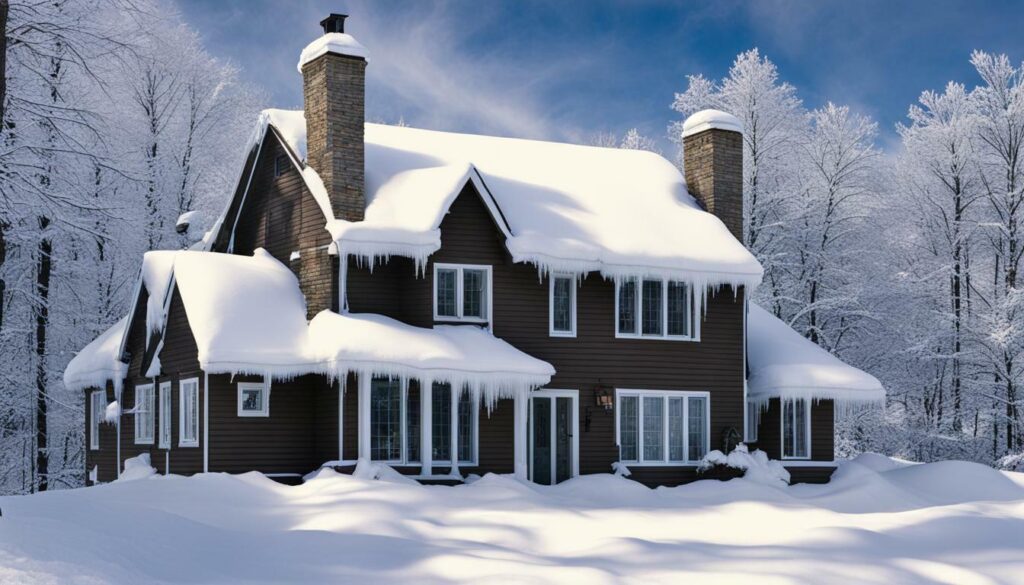
By understanding how to calculate the snow load on your roof, you can determine its capacity to support heavy snow and make informed decisions for durable roofing solutions. Snow load refers to the weight of the snow that accumulates on a roof, and it is essential to ensure that your roof can withstand the load without compromising its structural integrity.
To calculate the snow load on your roof, you need to know the snow density and the depth of the snow. The snow density varies depending on factors such as temperature and moisture content. As a general guideline, assume that every inch of snow depth equals 1.25 pounds per square foot. For example, if you have 12 inches of snow on your roof, the snow load would be approximately 15 pounds per square foot (12 inches x 1.25 pounds per square foot).
Once you have determined the snow load per square foot, you can calculate the total load on your roof by multiplying the snow load per square foot by the total roof area. This will give you an estimate of the weight that your roof is supporting. It is important to note that this calculation provides an approximation, and it is always recommended to consult with a structural engineer or roofing professional for an accurate assessment.
| Snow Load (lbs/ft2) | Risk Level |
|---|---|
| Up to 20 | Minimal risk |
| 20-40 | Moderate risk |
| 40-60 | Elevated risk |
| Above 60 | High risk |
It is essential to compare the calculated snow load on your roof with its load-bearing capacity. Different types of roofs have varying load-bearing capacities, and exceeding this capacity can lead to structural damage or even roof collapse. If the calculated snow load exceeds the load-bearing capacity of your roof, it may be necessary to reinforce the roof or consider alternative roofing solutions that are snow load-resistant and durable.
Remember that accurately calculating the snow load on your roof is crucial for the safety and longevity of your home. If you are unsure about the calculations or have concerns about your roof’s ability to handle heavy snow, it is always best to consult with a professional roofing contractor or structural engineer who can provide expert advice and recommendations based on your specific situation.
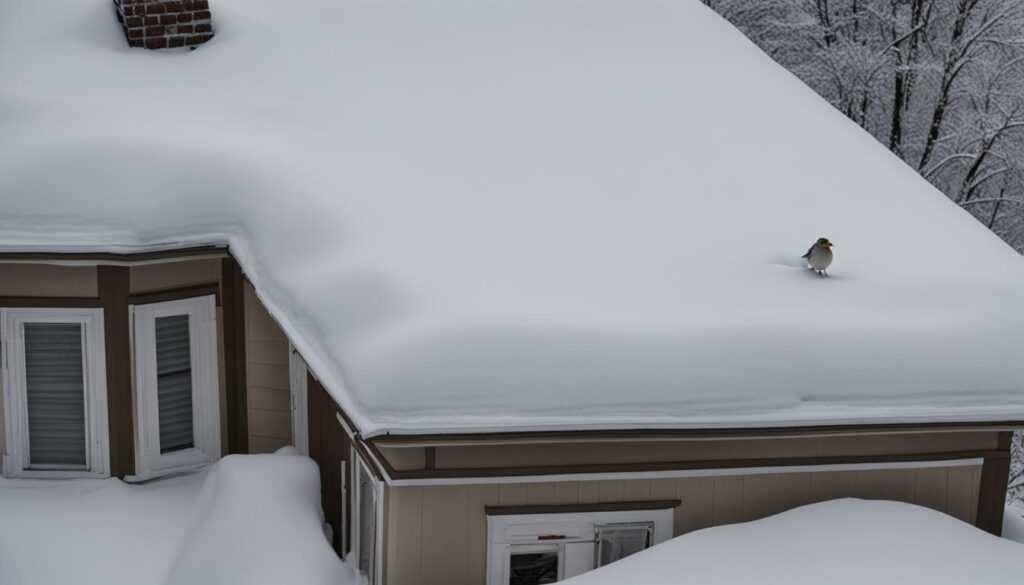
Removing Snow with a Roof Rake
A roof rake can be a valuable tool in safely and efficiently removing excess snow from your pitched roof, protecting your snow load-resistant roof from structural stress. By following the steps below, you can effectively reduce the weight load on your roof and minimize the risk of snow-related damage:
- Start at the edge: Begin raking from the edge of your roof and work your way towards the center. This ensures that the snow slides off in a controlled manner and reduces the risk of damaging the shingles.
- Leave a few inches: Avoid raking all the way down to the shingles. Leave a few inches of snow to avoid causing any harm to the roof’s surface. Removing excess snow is sufficient to relieve the weight load on the roof.
- Use long-handled rake: Opt for a roof rake with a long handle to reach higher areas of your roof without the need for climbing up. This allows you to safely remove snow from the ground.
- Be cautious of power lines: Pay attention to nearby power lines when using a roof rake. Ensure that you maintain a safe distance to avoid any accidental contact or electrocution.
- Stay on the ground: It’s best to avoid climbing onto your roof to remove snow, as it can be dangerous. The use of a roof rake allows you to remove snow while keeping your feet planted firmly on the ground.
Remember, removing all the snow from your roof is not necessary and can cause damage. Only remove excess snow to reduce the weight load and minimize the risk of structural stress. Following these steps, you can safely protect your home from heavy snowfall and maintain the integrity of your snow load-resistant roof.
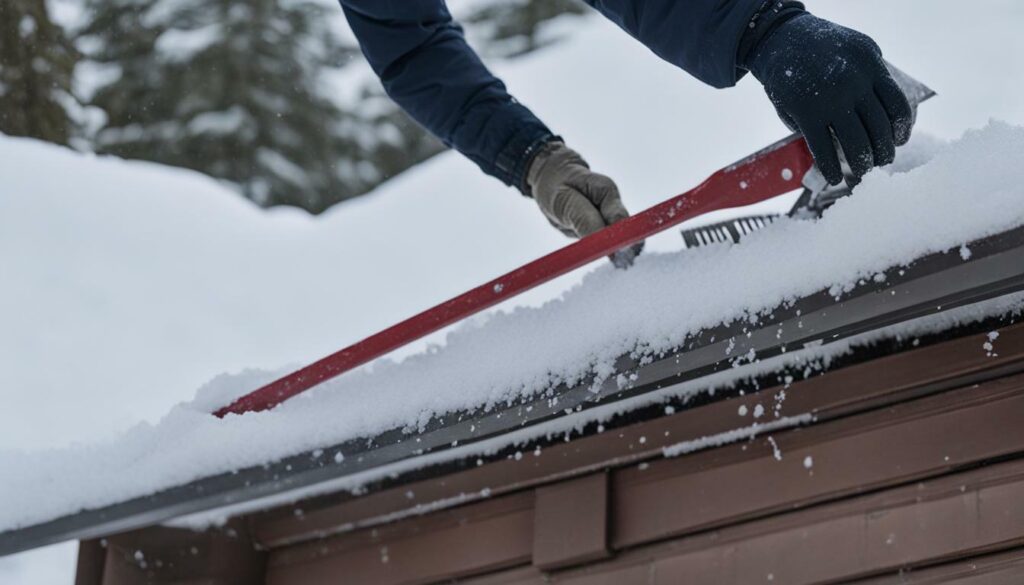
Professional Snow Removal Services
In cases where using a roof rake is insufficient, it is recommended to enlist the expertise of professional snow removal services to safeguard your roof from heavy snow accumulation. These professionals have the necessary equipment and experience to safely and efficiently remove snow from your roof, especially in areas with flat roofs or heavy snowfall. Hiring a professional snow removal service can help prevent potential damage to your roof and ensure the safety of both your home and yourself.
Professional snow removal services utilize various techniques and tools to effectively remove snow from your roof without causing any harm. They have access to specialized equipment, such as snow blowers and roof-safe snow shovels, that allow them to quickly and efficiently clear your roof of snow. Additionally, these services employ trained professionals who understand the nuances of snow removal and can assess the specific needs of your roof.
By hiring experts in snow removal, you can have peace of mind knowing that your roof is in capable hands. These professionals are equipped to handle the challenges posed by heavy snowfall and can prioritize the safety and integrity of your roof. They have the knowledge and experience to identify potential issues, such as ice dams or structural weaknesses, and can take appropriate measures to address them.
When selecting a professional snow removal service, it is important to choose a reputable and experienced company. Look for companies that are licensed and insured, as this ensures that they adhere to industry standards and can protect you from any liability. It is also beneficial to read customer reviews and ask for recommendations from friends or neighbors who have used snow removal services in the past.
| Benefits of Professional Snow Removal Services |
|---|
| 1. Safe and efficient snow removal |
| 2. Specialized equipment and techniques |
| 3. Experienced professionals with knowledge of snow removal |
| 4. Identification and mitigation of potential roof issues |
| 5. Licensed and insured companies for peace of mind |
When it comes to protecting your home from heavy snowfall, professional snow removal services play a vital role. Their expertise and resources ensure that your roof remains in top condition, even during the most severe winter weather. By enlisting their services, you can have confidence in the safety and longevity of your roof.
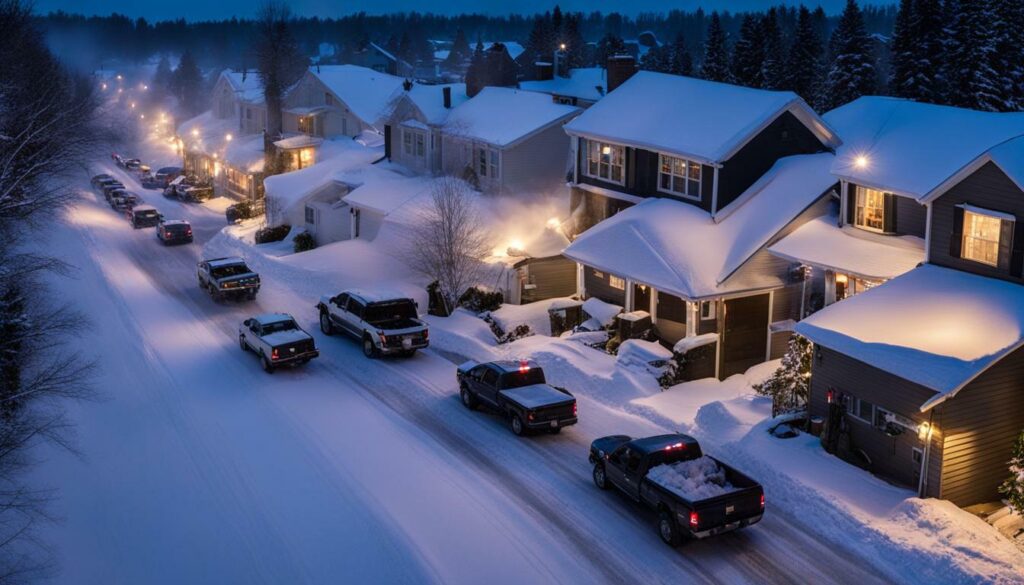
Selecting a suitable roof design, specifically those with steeper pitches, is essential to ensure your roof can withstand heavy snow loads and effectively shed snow. Steeper pitched roofs, such as gambrel, shed, hip, or gable roofs, are better equipped to handle the weight of snow and prevent accumulation, reducing the risk of structural damage or roof collapse.
These roof designs allow snow to slide off more easily, preventing excessive snow buildup. The angle of the roof helps distribute the weight of the snow more evenly, reducing the stress on your roof’s structure. Additionally, the steeper pitch helps prevent the formation of ice dams by allowing melted snow to flow off the roof more quickly.
For areas with heavy snowfall, the right roof design is crucial to safeguarding your home and protecting it from the potentially damaging effects of snow. Consult with roofing professionals who can assess your specific needs and recommend the most suitable roof design for your property.
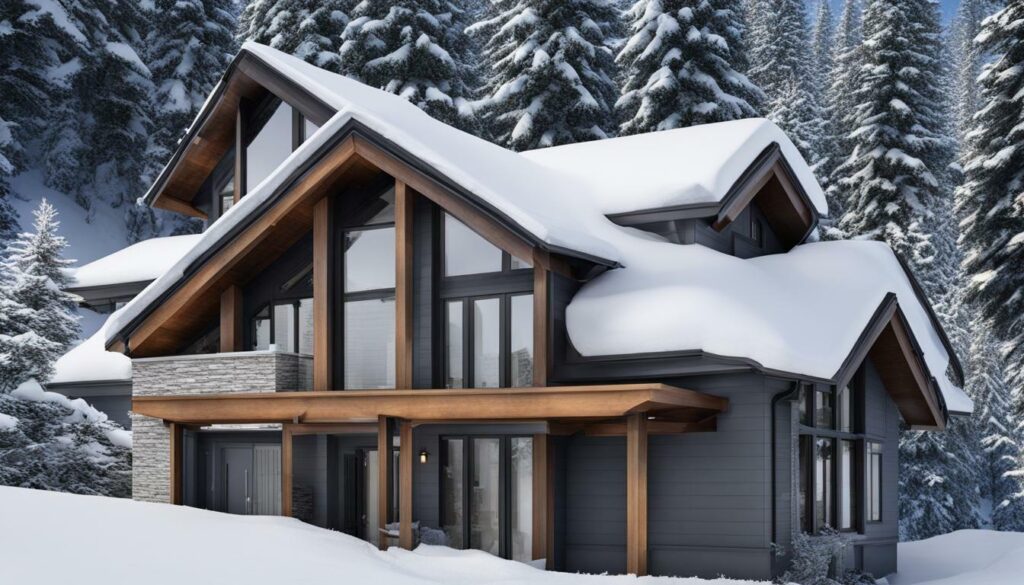
Choosing a suitable roof design is a proactive step towards ensuring the longevity and safety of your home during heavy snowfall. By opting for steeper pitches and designs that allow snow to shed easily, you can minimize the risk of roof damage and maintain a secure and weather-resistant home.
Advantages of Steeper Pitched Roofs
When it comes to heavy snowfall, roofs with steeper pitches offer several advantages:
- Improved snow shedding: The steeper angle of the roof allows snow to slide off more easily, preventing accumulation and reducing the load on your roof.
- Prevention of ice dam formation: The rapid shedding of snow helps prevent the formation of ice dams, which can lead to water leaks and damage to your home’s interior.
- Enhanced structural integrity: Steeper pitched roofs distribute the weight of the snow more evenly, reducing the stress on your roof’s structure and minimizing the risk of roof collapse.
- Long-term durability: Roof designs with steeper pitches are generally more durable and resistant to the effects of severe weather conditions, ensuring your roof can withstand heavy snow loads year after year.
In conclusion, selecting a suitable roof design, specifically one with a steeper pitch, is vital in regions prone to heavy snowfall. These designs allow for effective snow shedding, prevent ice dam formation, and enhance the structural integrity of your roof. By consulting with professionals and considering the advantages of steeper pitched roofs, you can ensure your home remains well-protected during winter and minimize the risk of roof damage.
| Advantages of Steeper Pitched Roofs |
|---|
| Improved snow shedding |
| Prevention of ice dam formation |
| Enhanced structural integrity |
| Long-term durability |
Selecting the Right Roofing Material
Selecting the right roofing material is crucial in ensuring your roof is resilient to heavy snowfall and can effectively protect your home against the elements. It is essential to choose a material that is durable, snow-proof, and suitable for cold climates. Here are some options to consider:
| Roofing Material | Benefits |
|---|---|
| Metal Roof | Durable and long-lasting, metal roofs are known for their ability to shed snow easily. They are resistant to ice dams and can withstand the weight of heavy snowfall. |
| Tile Roof | Tile roofs are highly resistant to extreme temperatures and can handle heavy snow loads. They offer excellent insulation and are aesthetically pleasing. |
| Asphalt Shingles | Asphalt shingles are a popular choice for snow-prone areas. They are cost-effective, durable, and can resist damage from hail and heavy snow. |
When selecting a roofing material, it is essential to consult with professionals who can assess the specific needs of your home and the local climate. They can provide expert guidance on the best material for your area.
Quote: “Choosing the right roofing material is the first line of defense against heavy snowfall. It ensures your roof remains intact and protects your home from potential damage.” – Roofing Expert
Investing in the right roofing material is an investment in the long-term protection of your home. It is worth considering the advantages and disadvantages of each material, as well as their suitability for your specific climate and snowfall conditions.

Regular Inspections and Maintenance
Regular inspections and maintenance are key to keeping your snow-proof roof in optimal condition, especially in heavy snowfall areas, as they help identify and address potential problems promptly. By conducting regular inspections, you can ensure that your roof is built to withstand the weight of heavy snow load and prevent any structural damage that may occur. Here are some essential maintenance tasks to consider:
- Check for loose or damaged shingles. High winds and heavy snowfall can dislodge shingles, leaving your roof vulnerable to leaks and water damage.
- Inspect the flashing and seals around vents, skylights, and chimneys. These areas are prone to leaks and should be properly sealed to prevent water penetration.
- Clean debris from gutters and downspouts. Clogged gutters can cause water to back up and seep into your roof, leading to water damage and potential ice dam formation.
- Examine the attic for signs of moisture or water damage. Moisture in the attic can indicate a problem with your roof, such as leaks or inadequate ventilation.
Additionally, during the winter months, it’s important to monitor snow accumulation on your roof after each snowfall. Excessive snow can put a strain on your roof and increase the risk of collapse. If you notice significant snow buildup, it may be necessary to remove some of the snow using a roof rake or hire a professional snow removal service.
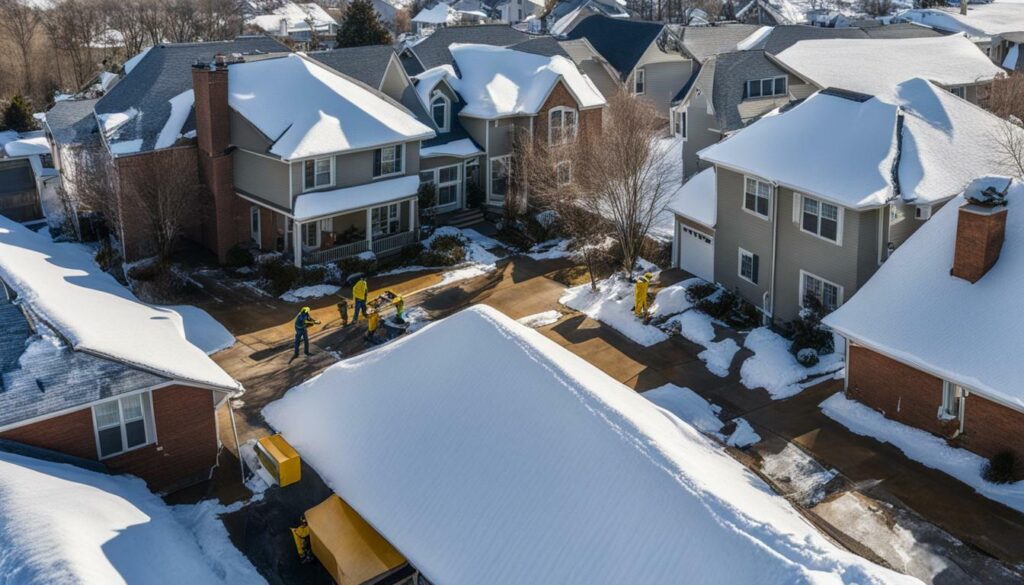
| Task | Frequency |
|---|---|
| Inspect roof and shingles | Twice a year |
| Check flashing and seals | Once a year |
| Clean gutters and downspouts | At least twice a year |
| Examine attic for moisture | Twice a year |
Maintaining regular inspections and addressing any issues promptly will help extend the lifespan of your snow-proof roof and ensure it provides adequate protection for your home during heavy snowfall. Remember, it’s always best to consult with roofing professionals for more specific guidance and recommendations tailored to your roof’s design and the climate in your area.
Installing Snow Brackets: Protect Your Snow-Proof Roof
Installing snow brackets or guards can be an effective measure to protect your snow-proof roof from ice dams and potential damage from sliding snow and ice. Snow brackets are specially designed attachments that can be installed along the edge of your roof, helping to prevent snow and ice from sliding off in large chunks. This not only reduces the risk of injury from falling snow and ice but also helps to prevent ice dams from forming.
Ice dams occur when snow on your roof melts and refreezes at the edges, causing a buildup of ice that can block the flow of water. This can lead to water seeping under the shingles, causing damage to the roof and potentially leading to leaks inside your home. Snow brackets help to break up the snow and ice as it melts, allowing for a more controlled release of water, preventing ice dams from forming and reducing the risk of damage.
How do snow brackets work?
Snow brackets are typically installed in rows along the eaves of your roof, using screws or other fasteners. They are designed to create small gaps between the roof surface and the snow, allowing for controlled melting and minimizing the risk of sudden snow slides. The brackets also provide additional support to the roof, helping to distribute the weight of the snow load more evenly.
| Benefits of Installing Snow Brackets |
|---|
|
By installing snow brackets, you can ensure that your snow-proof roof remains protected throughout the winter months. However, it’s important to note that snow brackets are not a one-size-fits-all solution. The number and spacing of brackets required will depend on various factors, including the slope of your roof, the amount of snowfall in your area, and the architectural design.
If you’re unsure about the installation of snow brackets or need assistance in determining the right placement, it’s recommended to consult with a professional roofing contractor. They can provide expert advice tailored to your specific roof design and ensure that the snow brackets are installed correctly, maximizing their effectiveness in protecting your roof from heavy snowfall and potential damage.
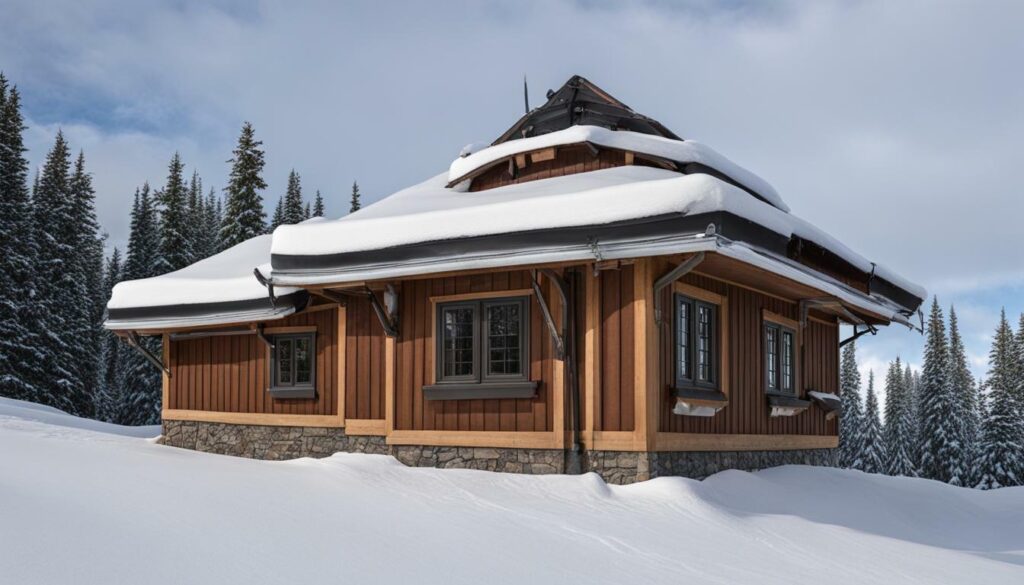
By taking proactive measures like installing snow brackets, you can safeguard your snow-proof roof and mitigate the risks associated with ice dams and sliding snow. Remember, prevention is key when it comes to protecting your home from heavy snowfall. Ensure you have a robust snow management strategy in place to maintain the integrity of your roof and safeguard your investment for years to come.
Maintaining Attic Ventilation and Insulation
Maintaining adequate attic ventilation and insulation plays a crucial role in preventing ice dam formation and maintaining the integrity of your snow-proof roof. Proper ventilation allows air to circulate, preventing moisture buildup and reducing the risk of condensation that can contribute to ice dam formation.
Inadequate insulation can result in heat loss from your home, accelerating snow melting on the roof. When the melted snow flows down to the eaves, it refreezes, forming ice dams. These ice dams can cause water to seep under your shingles, leading to leaks and potential damage to your roof and interior.
To ensure your attic ventilation and insulation are adequate, consider the following points:
- Inspect your attic: Check for proper ventilation openings, such as soffit vents and ridge vents. Make sure they are free from obstruction and allow sufficient airflow.
- Verify insulation levels: Ensure your attic is well-insulated with the recommended amount of insulation. The appropriate R-value will depend on your climate zone, so consult with professionals or refer to local building codes for guidance.
- Seal air leaks: Identify and seal any gaps or cracks in your attic, such as around vents, pipes, or electrical wires. This prevents warm air from escaping and cold air from infiltrating your attic space.
By maintaining proper attic ventilation and insulation, you create a barrier against ice dams and minimize the risk of roof damage. Remember to address any issues promptly and consult with professionals if you require assistance or guidance.
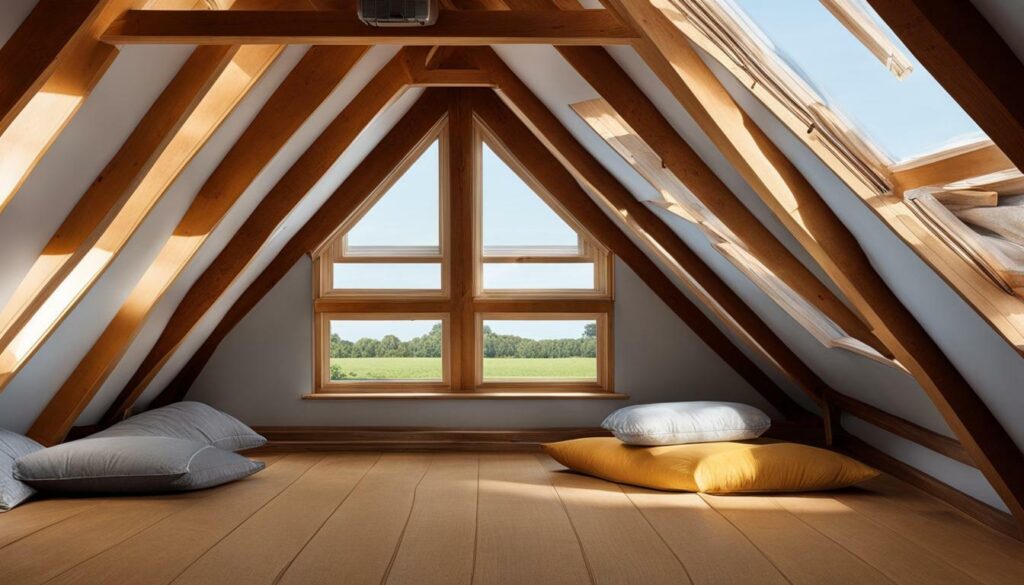
| Benefits of Proper Attic Ventilation | Benefits of Adequate Attic Insulation |
|---|---|
| Prevents condensation and moisture buildup | Reduces heat loss and lowers energy bills |
| Helps regulate attic temperature | Improves indoor comfort and temperature consistency |
| Extends the lifespan of your roof and shingles | Enhances soundproofing and reduces outside noise |
| Prevents mold and mildew growth | Increases the resale value of your home |
Conclusion
By implementing these roofing solutions for heavy snowfall areas, you can protect your home from potential damage caused by snow accumulation and ensure the longevity of your roof.
Protecting your home from heavy snowfall requires proper roofing solutions. Snow buildup can cause structural stress, damage to shingles, and even roof collapse. To prevent these issues, consider the following tips:
- Prevent ice dams with heating cables: Install weather-resistant and insulated electric cables along your roof and gutters to keep ice out of the eaves.
- Calculate snow load: Assume that every inch of snow depth equals 1.25 pounds per square foot. Use this equation to determine the pounds per square foot your roof is supporting.
- Remove snow with a roof rake: Use a long-handled roof rake to remove excess snow from your pitched roof. Start at the edge and work your way in, leaving a few inches to avoid damaging the shingles.
- Call professionals for snow removal: If using a rake is not enough, hire a professional snow removal service to safely remove snow from your roof, especially for flat roofs or heavy snowfall areas.
- Choose suitable roof designs: Consider roof designs that can withstand extreme weather conditions. Steeper pitches, like gambrel, shed, hip, or gable roofs, are better equipped to handle heavy snow loads.
- Select the right roofing material: Some materials, like metal, tile, or asphalt shingles, are better equipped to withstand severe weather conditions. Consult with professionals to choose the appropriate material for your area.
- Conduct regular inspections and maintenance: Inspect your roof before winter to identify any existing issues that may be worsened by snow and ice buildup. Regular inspections during winter help monitor snow accumulation and identify areas of concern.
- Install snow brackets: Use snow brackets or guards to prevent snow and ice from sliding off the roof. This helps prevent ice dam formation and reduces the risk of damage from falling snow and ice.
- Maintain attic ventilation and insulation: Proper attic ventilation and insulation can prevent ice dam formation by allowing heat to escape and reducing heat loss from the building.
- Consider heating cables: Install heating cables along the roof’s edge to melt snow and prevent ice dams. This is particularly effective in areas with a history of ice dam problems.
Remember that removing all snow from the roof is not necessary and can cause damage. Only remove excess snow to reduce the weight load on the roof. By following these solutions, you can protect your home from heavy snowfall and minimize the risk of roof damage.
FAQ
Q: What are the roofing solutions for heavy snowfall areas?
A: Roofing solutions for heavy snowfall areas include installing heating cables to prevent ice dams, calculating snow load to determine the weight your roof can support, removing snow with a roof rake, hiring professional snow removal services, choosing suitable roof designs, selecting the right roofing material, conducting regular inspections and maintenance, installing snow brackets, and maintaining attic ventilation and insulation.
Q: Why is it important to have snow-proof roofs?
A: Snow-proof roofs are crucial in heavy snowfall areas because they can withstand heavy snow loads without structural stress or damage. They ensure the safety and integrity of your home during severe weather conditions.
Q: How can heating cables prevent ice dams?
A: Heating cables can prevent ice dams by melting snow and ice along the roof and gutters. By keeping the eaves and gutters clear of ice, they protect against damage caused by ice buildup, such as structural stress and shingle damage.
Q: How do I calculate the snow load on my roof?
A: To calculate the snow load on your roof, assume that every inch of snow depth equals 1.25 pounds per square foot. Multiply the snow depth by 1.25 to determine the pounds per square foot your roof is supporting.
Q: How can I remove snow from my pitched roof?
A: You can use a roof rake to remove excess snow from your pitched roof. Start at the edge and work your way in, leaving a few inches to avoid damaging the shingles. This helps reduce the weight load on the roof and prevents potential damage caused by heavy snow accumulation.
Q: Should I hire professional snow removal services?
A: If using a roof rake is not enough to remove snow from your roof, especially for flat roofs or areas with heavy snowfall, it is advisable to hire professional snow removal services. They have the expertise and equipment to safely and effectively remove snow without risking personal injury or roof damage.
Q: What are suitable roof designs for heavy snowfall areas?
A: Suitable roof designs for heavy snowfall areas include gambrel, shed, hip, or gable roofs. These designs have steeper pitches, which allow snow to shed more easily and reduce the risk of structural stress or roof collapse.
Q: What is the right roofing material for heavy snowfall areas?
A: Metal, tile, and asphalt shingles are examples of roofing materials that are better equipped to withstand severe weather conditions, including heavy snowfall. Consult with professionals to choose the appropriate material for your specific area and climate.
Q: How important are regular inspections and maintenance for snow-proof roofs?
A: Regular inspections and maintenance are crucial for snow-proof roofs. Before winter, inspect your roof to identify any existing issues that may worsen due to snow and ice buildup. Regular inspections during winter help monitor snow accumulation and identify areas of concern that need immediate attention.
Q: What are snow brackets, and why are they important?
A: Snow brackets or guards are installed on roofs to prevent snow and ice from sliding off. They help prevent ice dam formation and reduce the risk of damage from falling snow and ice. Snow brackets are an essential element of snow-proof roofs.
Q: How does attic ventilation and insulation help prevent ice dam formation?
A: Proper attic ventilation and insulation play a significant role in preventing ice dam formation. They allow heat to escape, reducing the likelihood of snow melting on the roof and refreezing at the eaves. This helps maintain a consistent roof temperature and reduces the risk of ice dams.
